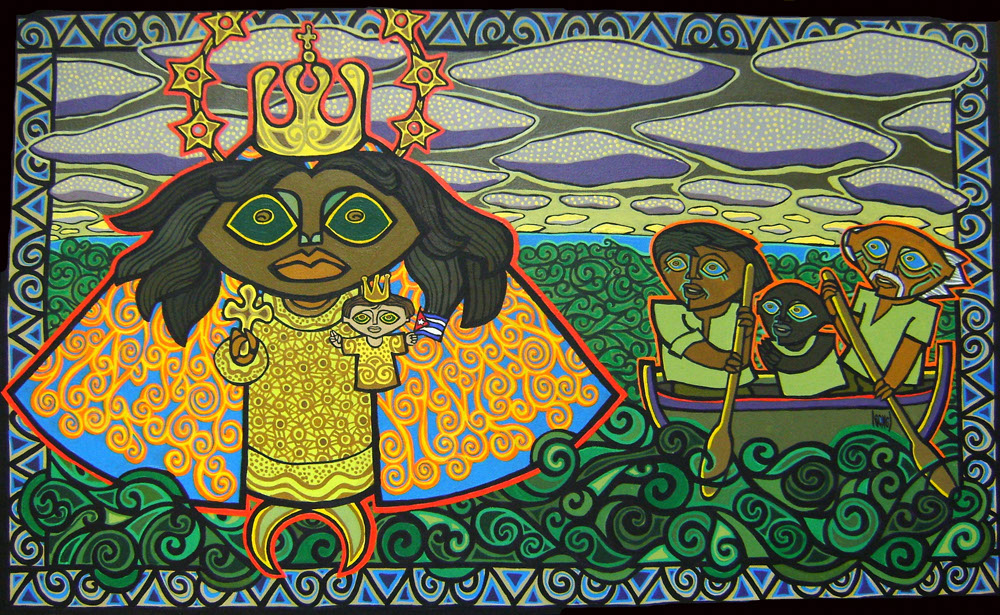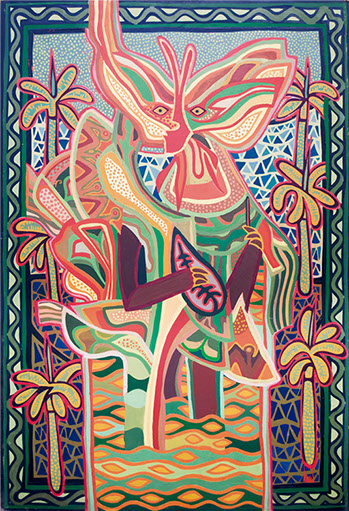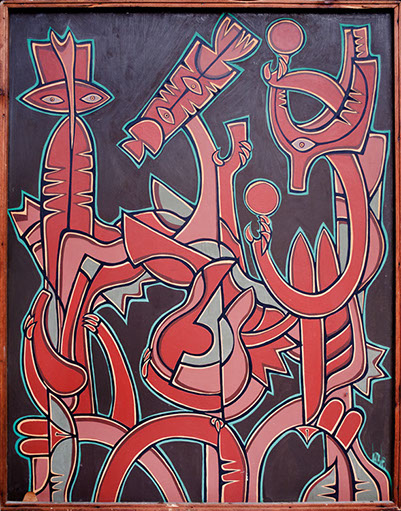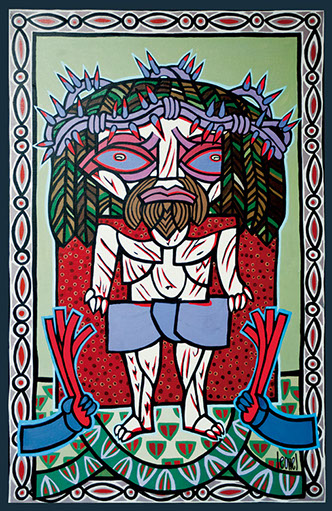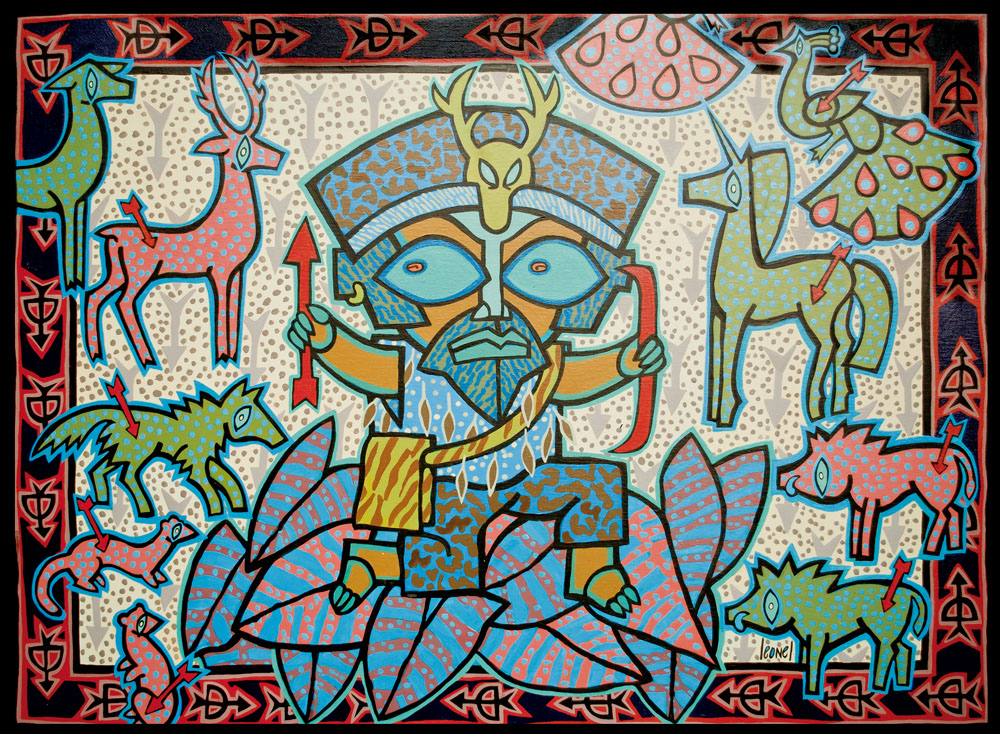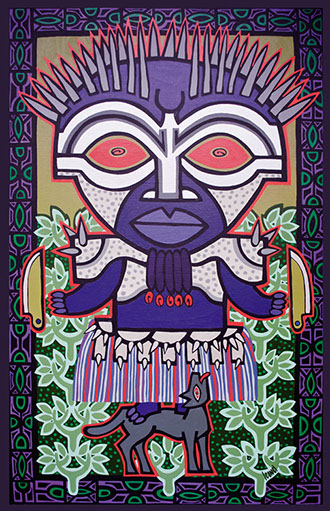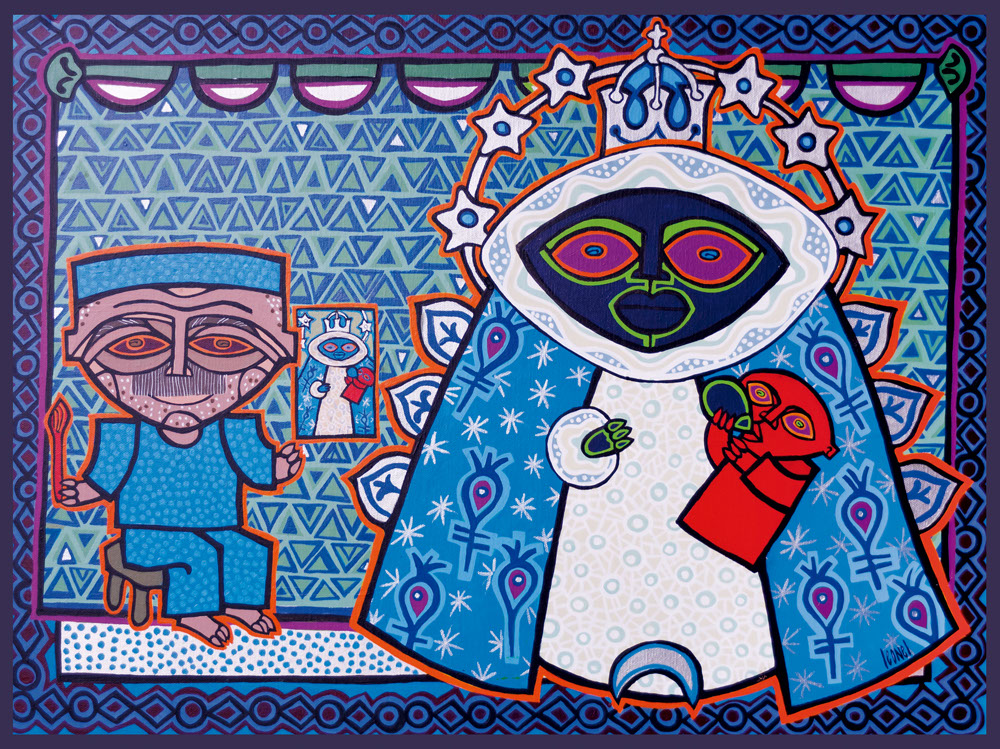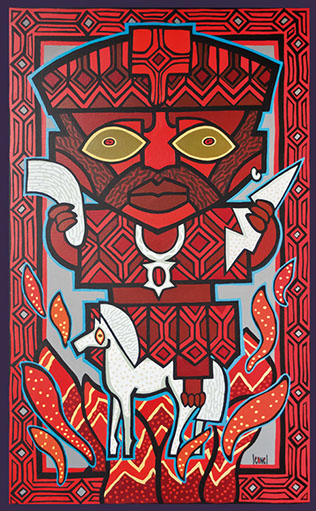Los orishas plasmados en la obra plástica del artista Leonel Morales buscan y reciclan la idealización expresiva de su estilo, inspirado por los artistas nigerianos en que se funden, se imbrican con las figuras divinas, las energías cósmicas de los legendarios reyes ancestrales poseedores de los cuatro elementos de la naturaleza.
Obatalá, orisha fun fun, dueño de las cabezas, durmió bajo los efectos del vino de palma, rodeado de su iruke y las palomas. Leonel nos lo representa con una expresión congelada en su imposibilidad tranquila, con ojos almendrados, estirados hacia las sienes y pupilas proyectando el mundo... Las ocho plumas de loro que marcan el oddun Eyeunle, el elemento aire, atributo de los dioses creadores de los panteones egipcios, de los aborígenes americanos, son elementos esenciales de su realeza: contemplación, ligereza, elevación, vuelo. Obatalá sostiene hierático su Iruke, insignia del poder de la fuerza y la prosperidad.
Leonel con sus realizaciones del panteón de la liturgia de la regla de Ocha o Santería asocia la belleza con la armonía de la fisonomía con la brillantez de una composición a la usanza medieval catalana y el arte naif del país de los yorubas. Sus elementos rituales que los distinguen: las estrellas y los cuatros vientos de Oya, la voluntariosa y guerrera, en su multicolor mundo de la floración, armada de flechas, venados y tigres, en gamas de ocres, verdes de Ochosi, el cazador desdoblamiento de Oggún el guerrero; de Elegguá con güiros, juguetes, trompos y papalotes, incansable niño de los destinos; Changó guerrero, amante, con su Oché, su caballo, sus palmas, rodeado, en el rojo y blanco, de sus amores eternos: Oya, Ochun y Obba.
(...) El artista nos recrea en su arte y nos adentra en la espiritualidad de esta liturgia, nos imbrica en el amor a la tierra, nuestra tierra cubana de soles incandescentes: mares encrespados en azules multigamaticos; nos muestra el verdor de sus paisajes que se funden en los ocres de su fuego interior y a su Ochukua, la luna que nace y renace en su ciclo reproductivo.
Esta exposición del artista Leonel Morales, es un “oru” a la imaginación y creatividad de nuestra identidad nacional.
Natalia Bolívar, 2000
The orichas that appear in the work of the artist Leonel Morales search out and recycle the expressive idealization of his style, inspired by Nigerian artists
in which the cosmic energy of the legendary ancestral kings, who own the four elements of nature, blend and overlap with divine figures.
Obatalá, the oricha fun fun, god of heads, slept under the effects of palm wine, surrounded by his iruke and the doves. Leonel presents him to us with a frozen expression of impossible calm, with almond-shaped eyes stretched toward his temples and pupils faced toward the world... The eight parrot feathers marking the oddun Eyeunle, the air element, attribute of the creator gods of the Egyptian pantheon, or the Native Americans, are essential elements of his kingship: contemplation, lightness, elevation, flight. Obatalá raises his Iruke like a priest, the insignia of power over strength and prosperity.
Leonel with his embodiments of the pantheon of the liturgy of the Regla de Ocha or Santería associates beauty with harmony of the physiognomy with the brilliance of composition in the style of medieval Catalan art and the naive art of the land of the Yorubas. These are the ritual elements that distinguish them: the stars and the four winds of Oya, the willful warrior in her multicolor flowering world, armed with arrows, deer and tigers in shades of ocher; the greens of Ochosi, the hunter, paired with Oggún, the warrior; Elegguá with gourds, toys, tops, kites, the tireless child of the fates; Changó the warrior, lover with his Oché thunder axes, horse, palm fronds, surrounded in red and white by his eternal loves—Oya, Ochún, and Obba.
(...) The artist reproduces us in his art and takes us into the spirituality of this liturgy, involves us in the love for the land, our Cuban land of burning suns, seas curled in multi-hued blues. He shows the green of its landscapes that blend into ochers in its internal fire and its Ochukua, the moon that is born and reborn in its reproductive cycle.
This exhibition of the artist Leonel Morales is an oru to the imagination and creativity of our national identity.
Natalia Bolívar, 2000
proyecto y curaduría:/project concept and curator: Alejandro de la Fuente
Agradecemos a la Fundación Ford por su apoyo para este proyecto /
/ Thanks to Ford Foundation for their support for this project"
web design: Los Fieras
